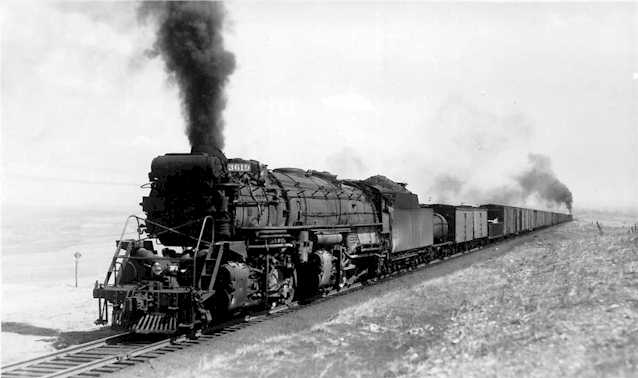

Duluth, Missabe & Iron Range classes M-3 and M-4
In the late 1930s the DM&IR was in need of new locomotives that would be able to handle 115-car, 8750-ton trains over .62% grades without stalling. The Western Pacific 2-8-8-2 was used as a basis for its design. The larger cab required a longer and heavier frame, therefore a 4-wheel trailing truck was used. Roller bearings were used on all locomotive and tender axles. The DM&IR was the only road who chose to use "pedestal" or "centipede" tenders with their Yellowstones.DM&IR was pleased with the first batch (class M-3) of 8 received from Baldwin in 1941 so they ordered 10 duplicates (class M-4). They were completed late in 1943 after much of DM&IR's traffic had subsided, so some of the M-4s were leased by and delivered directly to the Denver & Rio Grande Western. The following winter the D&RGW again borrowed the 2-8-8-4s for use as helpers over the 10,239-foot Tennessee Pass crossing of the continental Divide. The D&RGW sent a telegram to the DM&IR stating that the Yellowstones were the finest steam locomotives to ever operate on its road.
On the DM&IR they were used to pull ore trains throughout the Duluth area. For the most part, ore trains had to be pulled downhill to the ore docks on Lake Superior in Duluth and Two Harbors. These trips did not require the enormous pulling force of the Yellowstones. Surprisingly, the limiting factor (as far as what the iron range locomotives could pull) was the 2.2 percent grade from Duluth up to the yards in Proctor. The ore cars had to be returned empty to these yards for sorting. I had once read that it was the task of returning ore cars up this hill where these Yellowstones worked their hardest. However, someone else has informed me that the Yellowstones were never used to pull empties from Duluth to Proctor (older 2-8-8-2s, newer 2-10-4s and 0-10-2s were used for this service). Yet another person said that he spoke to a couple people (including the diesel shop forman who used to fire the Yellowstones and a former engineer on the Yellowstones) at the Proctor roundhouse while 227 was being restored in preparation for its display in the museum in Duluth. They said that it was possible to empty the tender of almost all coal and water while pulling a load of empty ore cars up the hill from Duluth to Proctor. This is to say: 25,000 gallons water and 25-26 tons of coal! This is hard to believe and perhaps it is a bit of an exaggeration, but it does show that this was one or the more difficult tasks for the Yellowstones. They were all retired between 1958 and 1963.